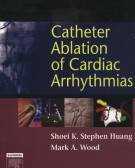|
|
|
| |
 |
|
|

|
 推薦指數:
推薦指數:





|
|
- 內容介紹
|
Catheter Ablation of Cardiac Arrhythmias
By Shoei K. Stephen Huang, MD (黃水坤教授)
中國醫藥大學校長
and Mark A. Wood, MD
720 pages 461 ills
Trim size 8 X 10 7/8 in
Copyright 2006
Description
The breadth and range of the topics covered, and the consistent organization of each chapter, give you simple but detailed access to information on anatomy, diagnostic criteria, differential diagnosis, mapping, and ablation. The book includes a unique section on troubleshooting difficult cases for each arrhythmia, and the use of tables, illustrations, and high-quality figures is unmatched among publications in the field.
Key Features
Includes comprehensive and detailed coverage of all arrhytmias and ablation technologies.
Uses consistent chapter format to make accessing information easy.
Outlines a systematic approach to specific problems encountered in the laboratory along with solutions.
Utilizes extensive tables to summarize key information in each chapter.
Presents specific “hard to remember” numerical information used in diagnosis and mapping.
Table of Contents
Part I: Fundamental Concepts of Catheter Energy Applications
Chapter 1: Biophysics of Radiofrequency Lesion Formation
Chapter 2: Titration of Radiofrequency Energy During Endocardial Catheter Ablation
Chapter 3: Irrigated and Cool-tip Radiofrequency Catheter Ablation
Chapter 4: Catheter Cryoablation: Biophysics and Applications
Chapter 5: Catheter Ultrasound, Microwave and Laser: Biophysics and Applications
Part II: Cardiac Mapping and Imaging
Chapter 6: Fluoroscopic Heart Anatomy for Catheter Mapping and Ablation of Arrhythmias
Chapter 7: Fundamentals of Intracardiac Mapping
Chapter 8: Advanced Catheter Mapping and Navigation Systems
Chapter 9: Role of Intracardiac Echocardiography in Clinical and Experimental Electrophysiology
Part III: Catheter Ablation of Atrial Tachycardia and Flutter
Chapter 10: Ablation of Focal Atrial Tachycardias
Chapter 11: Ablation of Isthmus-Dependent Atrial Flutters
Chapter 12: Ablation of Non-Isthmus-Dependent Atrial Flutter and Atrial Macroreentry
Chapter 13: Ablation of Postoperative Atrial Tachycardia in Congenital Heart Disease Patients
Part IV: Catheter Ablation for Atrial Fibrillation
Chapter 14: Atrioventricular Junction Ablation and Modification for Heart Rate Control of Atrial Fibrillation
Chapter 15: Segmental Pulmonary Vein Isolation for Atrial Fibrillation
Chapter 16: Catheter Ablation of Paroxysmal Atrial Fibrillation Originating from the Non-Pulmonary Vein Areas
Chapter 17: Linear Ablation for Atrial Fibrillation
Part V: Catheter Ablation of Atrioventricular Nodal Reentrant Tachycardia
Chapter 18: Ablation of Atrioventricular Nodal Reentry by the Anatomic Approach
Chapter 19: Ablation of Atrioventricular Nodal Reentrant Tachycardia and Variants Guided by Intracardiac Recordings
Part VI: Catheter Ablation of Accessory Atrioventricular Connections
Chapter 20: Ablation of Free-Wall Accessory Pathways
Chapter 21: Ablation of Posteroseptal Accessory Pathways
Chapter 22: Catheter Ablation of Superioparaseptal (“Anteroseptal”) and Midseptal Accessory Pathways
Chapter 23: Ablation of Atriofascicular (“Mahaim Fiber”) Accessory Pathways
Chapter 24: Special Problems in Ablation of Accessory Pathways
Part VII: Catheter Ablation of Ventricular Tachycardia
Chapter 25: Ablation of Ventricular Outflow Tract Tachycardias
Chapter 26: Ablation of Idiopathic Left Ventricular Tachycardia
Chapter 27: Ablation of Ventricular Tachycardia with Coronary Artery Disease
Chapter 28: Ablation of Ventricular Tachycardia with Non-ischemic Heart Disease
Chapter 29: Ablation of Unstable Ventricular Tachycardia and Idiopathic Ventricular Fibrillation
Chapter 30: Epicardial Approach to Catheter Ablation for Ventricular Tachycardia
Chapter 31: Ablation of Ventricular Tachycardia with Congenital Heart Disease
Part VIII: Miscellaneous Topics
Chapter 32: Complications Associated with Radiofrequency Catheter Ablation of Cardiac Arrhythmias
Chapter 34: Special Considerations for Ablation of Pediatric Patients
|
|
|

